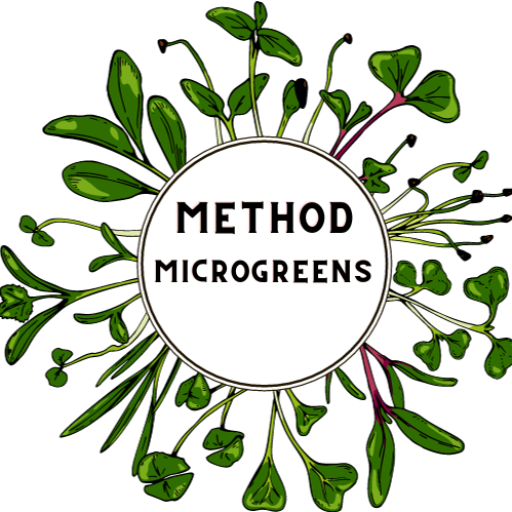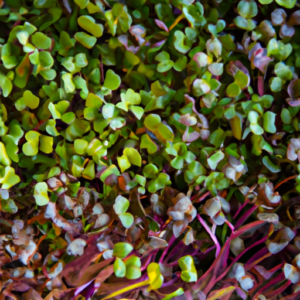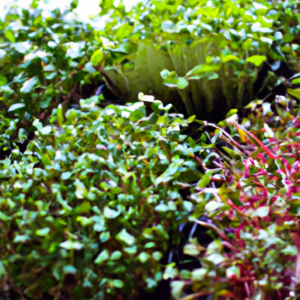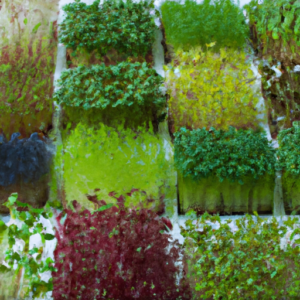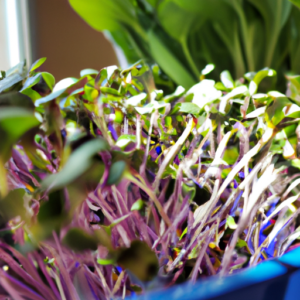Are you curious about the exciting world of microgreens? Look no further than Microgreens World, your go-to website for all things microgreens! Whether you’re interested in learning about the health benefits of microgreens, exploring new recipes, or discovering lucrative business strategies, Microgreens World has got you covered. From promoting hair health to aiding in natural detoxification, you’ll find a plethora of articles discussing the incredible benefits of microgreens. Plus, the website offers valuable information on specific microgreens varieties and how to cultivate a growth mindset for success in the microgreens business. So why wait? Start exploring the future of microgreens today on Microgreens World!
Benefits of Microgreens
Microgreens are not only delicious additions to your meals, but they also offer numerous health benefits. Incorporating microgreens into your diet can improve various aspects of your well-being, from hair and skin health to immune and digestive health. Additionally, microgreens can aid in weight management and provide natural detoxification for your body.
Microgreens and Hair Health
Microgreens can play a significant role in maintaining healthy and vibrant hair. They are packed with essential nutrients, such as vitamins A, C, and E, which are known to promote hair growth and prevent hair loss. These nutrients nourish the hair follicles and provide the necessary support for healthy hair growth. Including microgreens in your diet can help prevent hair breakage, strengthen your strands, and enhance the overall health of your hair.
Microgreens and Skin Health
If you’re looking to achieve a glowing complexion, microgreens can be a valuable addition to your skincare routine. These tiny greens are rich in antioxidants, such as vitamin C and beta-carotene, which can combat free radicals and protect your skin from damage caused by environmental factors. Microgreens also contain high levels of vitamins A and E, which are essential for maintaining healthy skin and promoting collagen production. Regular consumption of microgreens can help reduce skin inflammation, improve skin elasticity, and achieve a youthful complexion.
Microgreens and Eye Health
Protecting your eyesight is crucial, and microgreens can contribute to maintaining healthy vision. They are abundant in carotenoids, particularly lutein and zeaxanthin, which are known to promote eye health. These compounds act as antioxidants and filter harmful blue light, protecting the retina and reducing the risk of age-related macular degeneration and cataracts. Including microgreens in your diet can provide vital nutrients for your eyes and support long-term eye health.
Microgreens and Immune Health
Microgreens can give your immune system a boost with their powerful immune-enhancing properties. They contain a variety of vitamins and minerals, including vitamin C, vitamin A, vitamin E, and zinc, all of which are crucial for a healthy immune system. These nutrients help strengthen your body’s defense against pathogens, reduce inflammation, and support the production of immune cells. Including microgreens in your diet can improve your body’s ability to fight off infections and promote overall immune health.
Microgreens and Digestive Health
Maintaining a healthy digestive system is essential for your overall well-being, and microgreens can contribute to better digestion. These greens are rich in dietary fiber, which promotes regular bowel movements and helps prevent constipation. Fiber also functions as a prebiotic, nourishing the beneficial bacteria in your gut and supporting a healthy gut microbiome. The combination of vitamins, minerals, and antioxidants found in microgreens can also help reduce inflammation in the digestive tract and improve nutrient absorption.
Microgreens and Weight Management
If you’re looking to manage your weight effectively, incorporating microgreens into your meals can be an excellent strategy. Microgreens are low in calories but rich in nutrients, making them a perfect addition to a balanced and healthy diet. Their fiber content can help you feel fuller for longer, reducing the temptation to overeat. Furthermore, microgreens provide essential vitamins and minerals while keeping your calorie intake in check, ensuring you receive the necessary nutrients without unnecessary weight gain.
Microgreens and Natural Detoxification
Microgreens can aid in natural detoxification by supporting the body’s detoxifying organs, such as the liver and kidneys. They are a great source of chlorophyll, a pigment that helps remove toxins and heavy metals from the body. Additionally, microgreens contain antioxidants that combat oxidative stress and protect the organs involved in the detoxification process. Including microgreens in your diet can support your body’s natural cleansing mechanisms and promote overall detoxification.
Specific Microgreens Varieties
Microgreens come in a wide variety of flavors and textures, making them a versatile ingredient in your culinary endeavors. While there are numerous microgreens to choose from, quinoa microgreens deserve special attention due to their exceptional nutritional benefits.
Quinoa Microgreens
Quinoa microgreens are derived from the tiny seeds of the quinoa plant, which is highly regarded for its nutritional value. These microgreens boast a delicate and slightly peppery taste, making them a delightful addition to salads, sandwiches, and wraps. Quinoa microgreens are a rich source of protein, dietary fiber, vitamins, and minerals. They are particularly high in iron, making them an excellent choice for individuals looking to boost their iron intake without consuming meat. Additionally, quinoa microgreens contain essential amino acids, making them a complete protein source.
Nutritional Benefits of Quinoa Microgreens
Quinoa microgreens offer an impressive array of nutrients. They are a great source of vitamins A, B, C, and E, which promote healthy growth, provide antioxidant protection, and support immune function. Quinoa microgreens are also rich in minerals like calcium, magnesium, potassium, and phosphorus, which are vital for maintaining healthy bones and supporting various bodily functions. These microgreens are a nutritious addition to any meal and can help meet your daily nutrient requirements.
In addition to quinoa microgreens, there are several other nutritious microgreen varieties worth exploring.
Other Nutritious Microgreen Varieties
Microgreens like broccoli, kale, and arugula are becoming increasingly popular due to their exceptional nutritional profiles. Broccoli microgreens, for example, contain high levels of sulforaphane, a compound known for its anti-cancer properties. Kale microgreens are packed with vitamins A, C, and K, as well as antioxidants that promote heart health and support cognitive function. Arugula microgreens are rich in phytochemicals that can reduce inflammation and boost the immune system. Including these microgreens in your diet can provide a range of health benefits and elevate the nutrient content of your meals.
Exploring Different Flavors of Microgreens
One of the joys of incorporating microgreens into your diet is the opportunity to explore a multitude of flavors. From the delicate and slightly bitter taste of radish microgreens to the refreshing peppery flavor of watercress microgreens, the variety of flavors offered by microgreens can elevate your culinary creations. Other microgreens, such as cilantro, basil, and mustard greens, provide unique flavors that can enhance numerous dishes. Experimenting with different microgreen varieties can help you uncover new tastes and add vibrant freshness to your meals.
Microgreens Business Strategies
In addition to their remarkable health benefits, microgreens have gained popularity in the culinary industry. As a result, the microgreens business has become an exciting opportunity for entrepreneurs and those passionate about providing fresh and nutritious produce to their community. To succeed in the microgreens business, several key strategies should be considered.
Pricing Microgreens
Determining the appropriate pricing for your microgreens can be a crucial aspect of running a successful business. Factors to consider when setting prices include production costs, market demand, and competition analysis. It’s essential to strike a balance between offering competitive prices and ensuring profitability. Conducting thorough market research and understanding your target audience can help you determine the optimal price point for your microgreens.
Packaging Microgreens
Packaging plays a significant role in the presentation and preservation of your microgreens. It’s important to choose packaging materials that are not only visually appealing but also eco-friendly and functional. Consider using eco-friendly packaging options, such as compostable containers or reusable packaging. Additionally, proper labeling with relevant information about the microgreens, such as variety, nutritional benefits, and growing methods, can help attract customers and build trust in your brand.
Choosing Profitable Microgreens Varieties
While there is a wide variety of microgreens to choose from, not all may be equally profitable for your business. Factors such as consumer demand, growth rate, and ease of cultivation should be taken into account when selecting which microgreens to grow. Research local market trends and identify niche opportunities to ensure the microgreens you cultivate have a high demand and can bring a satisfactory return on investment.
Marketing Microgreens
Effectively marketing your microgreens is crucial for attracting customers and establishing a strong presence in the marketplace. Utilize various marketing channels, such as social media platforms, local farmers’ markets, and community events, to promote your microgreens. Share engaging content, including recipes, nutritional information, and success stories, to showcase the value and benefits of your microgreens. Consider partnering with local health-conscious businesses or collaborating with influencers in the health and wellness industry to expand your reach.
Selling Microgreens Locally
Selling microgreens locally can provide a steady customer base and foster a sense of community engagement. Establish relationships with local restaurants, cafes, and health food stores to showcase your microgreens as high-quality, locally grown produce. Participate in farmers’ markets and community events to directly connect with potential customers and educate them about the advantages of consuming microgreens. Building trust and loyalty within your local community can contribute to the long-term success of your microgreens business.
Selling Microgreens Online
Expanding your business beyond local sales by selling microgreens online can significantly increase your customer reach and revenue potential. Create an appealing and user-friendly website where customers can browse your microgreen offerings, place orders, and learn more about your business. Ensure smooth and efficient delivery of your microgreens by utilizing reliable shipping methods and packaging them properly to maintain freshness. Establishing an online presence can open doors to customers beyond your geographical location and create opportunities for growth.
Building Customer Loyalty
Building and maintaining strong relationships with your customers is essential for the long-term success of your microgreens business. Provide exceptional customer service, respond promptly to inquiries, and address any concerns or feedback. Consider implementing a loyalty program or offering incentives to encourage repeat customers. Going the extra mile in providing personalized service can help create a loyal customer base that supports your business and recommends your microgreens to others.
Establishing Partnerships with Restaurants and Chefs
Partnering with local restaurants and chefs can create valuable opportunities to showcase your microgreens and expand your customer base. Approach restaurants and chefs who prioritize fresh and local ingredients in their menus. Offer to supply them with your microgreens and collaborate on creating unique dishes that highlight the flavor and nutritional benefits of microgreens. Establishing mutually beneficial partnerships with reputable establishments can elevate the reputation of your microgreens business and generate consistent sales.
Cultivating a Growth Mindset in the Microgreens Business
When starting and growing a microgreens business, cultivating a growth mindset is essential for long-term success. A growth mindset is the belief that abilities and intelligence can be developed through dedication, hard work, and continuous learning. Adopting a growth mindset can empower you to overcome challenges, embrace change, and seize opportunities for growth and innovation.
Understanding the Importance of a Growth Mindset
A growth mindset is key to navigating the ever-evolving microgreens industry. Recognize that setbacks and failures are learning opportunities and stepping stones toward growth. Embrace a mindset that values persistence, resilience, and a willingness to adapt and learn from mistakes. Understand that success in the microgreens business is not solely based on innate talent, but also on continuous improvement and the ability to adapt to changing market dynamics.
Developing Resilience and Adaptability
Building resilience and adaptability is crucial in the face of challenges and setbacks. The microgreens industry may present obstacles such as crop failures, market fluctuations, or regulatory changes. Cultivate the ability to bounce back from setbacks, learn from failures, and adapt your business strategies accordingly. Foster a mindset that welcomes change and sees challenges as opportunities for growth rather than obstacles to success.
Embracing Continuous Learning
The microgreens industry is constantly evolving, with new techniques, research, and market trends emerging regularly. Embrace a commitment to continuous learning and stay updated on the latest developments in microgreens cultivation, nutrition, and business strategies. Seek out educational resources, attend industry conferences and workshops, and connect with other microgreens growers to exchange knowledge and ideas. The willingness to learn and adapt is a hallmark of a growth mindset and can contribute to the continued growth and success of your business.
Overcoming Challenges in the Microgreens Business
Running a microgreens business comes with its fair share of challenges. From maintaining optimal growing conditions to managing inventory and meeting customer demands, entrepreneurship in the microgreens industry requires problem-solving skills and resilience. Approach challenges with a growth mindset, viewing them as opportunities to learn, improve, and innovate. Seek creative solutions, learn from industry experts, and draw inspiration from successful microgreens businesses to overcome obstacles and thrive in a competitive market.
Seeking Opportunities for Growth and Innovation
A growth mindset involves seeking opportunities for growth and innovation within the microgreens industry. Stay updated on emerging trends, market demands, and consumer preferences to identify potential areas for expansion or diversification. Consider offering unique microgreen varieties or exploring new culinary applications for microgreens. Embrace technological advancements and automation to enhance productivity and efficiency in your microgreens cultivation and business operations. By actively seeking opportunities for growth and innovation, you can position your microgreens business for long-term success.
Recipes with Microgreens
Incorporating microgreens into your meals not only adds a burst of freshness and color but also allows you to enjoy their nutritional benefits. Whether you’re creating a light salad or experimenting with unique flavor combinations, microgreens can elevate your culinary creations. Here are some delicious recipe ideas to inspire you:
Incorporating Microgreens into Salads
Salads are a fantastic canvas for showcasing the vibrant colors and textures of microgreens. Create a refreshing salad by combining your favorite leafy greens, such as spinach or lettuce, with a generous amount of microgreens. Add a variety of vegetables, such as cherry tomatoes, cucumbers, and bell peppers, for extra crunch and flavor. Top it off with a sprinkle of microgreens, such as radish, arugula, or sunflower shoots, to add a pop of color and a peppery taste. Drizzle your salad with a light vinaigrette or citrus dressing and enjoy a nutritious and visually appealing meal.
Microgreens as Toppings for Pizza and Pasta
Elevate your favorite pizza or pasta dishes by adding a handful of microgreens as a flavorful topping. After baking your pizza or cooking your pasta, generously sprinkle microgreens, such as basil, parsley, or pea shoots, over the top. The microgreens will add freshness and an extra layer of flavor to your dish. The vibrant colors of the microgreens will make your pizza or pasta visually appealing while providing nutritional value.
Microgreens in Smoothies and Juices
Take your morning smoothie or juice to the next level by incorporating microgreens. Add a handful of microgreens, such as kale, spinach, or wheatgrass, to your favorite fruit and vegetable blend. The microgreens will enhance the nutritional content of your beverage, providing a concentrated dose of vitamins and minerals. Experiment with different combinations to find your perfect blend and enjoy a refreshing and nutrient-packed start to your day.
Microgreens in Sandwiches and Wraps
Give your sandwiches and wraps a nutritional boost by layering them with microgreens. Whether you’re making a classic turkey and cheese sandwich or a flavorful veggie wrap, microgreens can add a vibrant crunch and unique flavor. Consider using microgreens such as mustard greens, broccoli, or cilantro to add a zesty and peppery taste. Not only will the microgreens enhance the nutritional value of your meal, but they will also provide an added texture and visual appeal.
Creative Uses of Microgreens in Various Dishes
Don’t limit yourself to traditional recipes when it comes to incorporating microgreens into your dishes. Get creative and experiment with new flavor combinations and culinary applications. Sprinkle microgreens on top of omelets, fold them into homemade sushi rolls, or blend them into spreads and dips for added freshness. The possibilities are endless, and microgreens can add a unique twist to both savory and sweet dishes.
Nutritional Value of Microgreens
Microgreens offer exceptional nutritional value, packing a punch of vitamins, minerals, and antioxidants in their tiny leaves. Despite their small size, microgreens are incredibly nutrient-dense and can provide a wide array of health benefits. Here’s a closer look at the nutritional content of microgreens and how they compare to their mature plant counterparts.
Exploring the Nutrient Content of Microgreens
Microgreens are young vegetable shoots that are harvested when they reach their first true leaves. This early stage of growth makes them especially rich in nutrients. Microgreens can contain up to 40 times more vitamins, minerals, and antioxidants compared to their mature plant counterparts. Their rapid growth allows them to concentrate these valuable compounds in a compact package, making them a powerhouse of nutrition.
Comparison of Nutrient Density with Mature Plants
Numerous studies have shown that microgreens have higher nutrient levels than the fully grown plants they are derived from. For example, red cabbage microgreens have been found to contain significantly higher levels of vitamin C, vitamin K, and vitamin E compared to mature red cabbage heads. Similarly, studies have shown that cilantro microgreens have higher levels of certain vitamins, such as vitamin C and vitamin E, compared to mature cilantro leaves. Incorporating microgreens into your diet can provide a concentrated dose of essential nutrients that may be lacking in mature produce.
Vitamins and Minerals in Microgreens
Microgreens are a fantastic source of vitamins and minerals that are essential for overall health and well-being. They typically contain high levels of vitamins A, C, and K, which play crucial roles in immune function, collagen production, and bone health. Microgreens are also rich in minerals such as potassium, iron, and calcium, which are necessary for maintaining healthy bodily functions. By consuming a variety of microgreens, you can diversify your nutrient intake and support optimal health.
Antioxidants and Phytochemicals in Microgreens
Microgreens are teeming with antioxidants and phytochemicals, which are bioactive compounds known for their protective properties and potential health benefits. Antioxidants neutralize harmful free radicals in the body, reducing oxidative stress and inflammation. Studies have shown that microgreens, such as broccoli and radish microgreens, contain high levels of specific antioxidant compounds, such as sulforaphane and quercetin. Including microgreens in your diet can provide you with a concentrated dose of these valuable compounds and boost your body’s defense against oxidative damage and chronic diseases.
Health Benefits of Microgreens
In addition to their impressive nutritional value, microgreens offer a range of health benefits that can support overall well-being. From enhancing digestion to managing blood sugar levels, here’s a closer look at the specific health benefits that microgreens can provide.
Boosting the Immune System
Microgreens are a rich source of immune-enhancing nutrients, such as vitamins A, C, and E. These vitamins play vital roles in supporting immune function, promoting the production of immune cells, and protecting the body against infections. Regular consumption of microgreens can help strengthen your immune system, making you more resilient to illnesses and disease.
Supporting Heart Health
Microgreens can contribute to heart health by providing essential nutrients that support cardiovascular function. They are abundant in vitamins, minerals, and antioxidants that help reduce inflammation, support blood vessel integrity, and regulate blood pressure. Microgreens, such as kale and spinach, contain high levels of nitrates, which have been shown to improve blood flow and promote heart health. Including microgreens in your diet can help maintain a healthy heart and reduce the risk of cardiovascular diseases.
Enhancing Digestion
Microgreens offer numerous benefits for the digestive system. Their high fiber content promotes regular bowel movements, preventing constipation and supporting a healthy digestive tract. Additionally, microgreens contain enzymes that aid in digestion and support optimal nutrient absorption. Furthermore, their antioxidant and anti-inflammatory properties can reduce inflammation in the digestive system, alleviating symptoms of gastrointestinal disorders. Incorporating microgreens into your meals can improve digestion and support a healthy gut.
Improving Skin Health
The high levels of vitamins and antioxidants found in microgreens can significantly improve skin health. Antioxidants protect the skin from damage caused by free radicals, preventing premature aging and reducing the appearance of wrinkles and fine lines. Vitamins A and E found in microgreens promote collagen production, which can improve skin elasticity and firmness. Including microgreens in your diet can help achieve a radiant complexion and maintain healthy, youthful-looking skin.
Reducing Inflammation
Inflammation is a natural response to injury or infection, but chronic inflammation can contribute to the development of various diseases. Microgreens possess anti-inflammatory properties that can help reduce chronic inflammation in the body. Their high antioxidant content neutralizes free radicals and reduces oxidative stress, which is a significant contributor to inflammation. Incorporating microgreens into your diet can promote a healthy inflammatory response and protect against chronic diseases associated with inflammation.
Managing Blood Sugar Levels
Microgreens can play a role in managing blood sugar levels due to their low glycemic index and high fiber content. Foods with a low glycemic index release sugar into the bloodstream slowly, preventing spikes in blood sugar levels. The fiber found in microgreens slows down the digestion and absorption of carbohydrates, further aiding in the regulation of blood sugar levels. Include microgreens in your meals to help maintain stable blood sugar levels and reduce the risk of developing type 2 diabetes.
Growing Microgreens at Home
Growing microgreens at home allows you to enjoy a continuous supply of these nutritious greens while adding a touch of freshness to your dishes. Whether you have limited space or a full-scale indoor garden, cultivating microgreens can be a rewarding and sustainable endeavor. Here’s a guide to help you get started:
Basic Requirements for Growing Microgreens
Microgreens can be grown indoors, making them an accessible option for most individuals. To grow microgreens successfully, you’ll need the following basic requirements:
- Growing trays or containers: Choose shallow trays or containers with good drainage to prevent waterlogging.
- Growing medium: Opt for a sterile growing medium, such as soilless mixes or coconut coir, to provide adequate nutrition and moisture retention for the microgreens.
- Seeds: Select high-quality seeds specifically labeled for microgreen production. Consider exploring various microgreen varieties to enjoy a diverse array of flavors and textures.
- Light source: Microgreens require adequate light for photosynthesis and healthy growth. If natural sunlight is limited, consider using grow lights to provide the necessary lighting conditions.
- Watering system: Maintain proper moisture levels by watering your microgreens regularly. Mist the growing medium or use a gentle watering technique to prevent soil disturbance.
Choosing the Right Seeds for Microgreens
The choice of seeds is a crucial aspect of microgreens cultivation. Different varieties of microgreens offer unique flavors, textures, and nutritional profiles. Consider growing a variety of microgreens to diversify your culinary options and maximize nutritional benefits. Start with seeds that are easy to grow, such as sunflower, radish, and pea shoots. As you gain experience, explore more challenging varieties like broccoli, kale, and cilantro. Ensure you source your seeds from reputable suppliers to ensure high-quality and contaminant-free seeds.
Planting and Germination Process for Microgreens
Planting microgreens is a straightforward process that can be done in a few simple steps:
- Prepare your growing trays or containers by adding a thin layer of moistened growing medium.
- Sprinkle the seeds evenly over the surface of the growing medium. Ensure proper seed density to prevent overcrowding.
- Gently press the seeds into the growing medium to establish good seed-to-soil contact.
- Cover the seeds with a thin layer of growing medium or use a humidity dome to create a suitable microclimate for germination.
- Place the trays or containers in a warm location with adequate light. Depending on the variety, microgreens typically germinate within a few days to a week.
- Once the seeds have germinated, remove the cover and ensure proper air circulation to prevent mold or fungal growth.
- Continue providing adequate light and moisture to support healthy microgreen growth.
Harvesting and Storing Microgreens
As your microgreens reach the desired height and develop their first true leaves, they are ready for harvest. Gently cut the microgreens just above the soil line using clean scissors or a sharp knife. Rinse the harvested microgreens with water and pat them dry using a clean towel or paper towels. Use them immediately for maximum freshness or store them in airtight containers lined with paper towels in the refrigerator. Properly stored microgreens can stay fresh for several days, allowing you to enjoy their nutritional benefits even after harvesting.
Common Mistakes to Avoid in Microgreens Cultivation
Microgreens cultivation can be a rewarding experience, but it’s important to avoid common mistakes that can hinder the growth and quality of your microgreens. Here are a few key pitfalls to avoid:
- Overwatering: Excessive moisture can lead to mold, fungus, and root rot. Only water your microgreens when the top layer of the growing medium feels dry.
- Insufficient light: Inadequate light can result in leggy and pale microgreens. Ensure your microgreens receive at least 6-8 hours of bright, indirect light per day or use grow lights to supplement natural sunlight.
- Improper seed density: Overcrowded seeds can hinder air circulation and lead to mold growth. Scatter seeds evenly to avoid overcrowding and provide sufficient space for each seed to grow.
- Inadequate nutrition: Microgreens rely on the nutrients in the growing medium for healthy growth. Ensure you use a nutrient-rich medium or supplement with organic fertilizers if necessary.
- Poor hygiene: Maintain a clean and hygienic environment to prevent the spread of pathogens and ensure the optimal growth of your microgreens. Use clean trays, tools, and uncontaminated water during cultivation.
Avoiding these common pitfalls can help you cultivate thriving and nutritious microgreens that will enhance your culinary creations and provide an endless supply of fresh produce.
Environmental Sustainability of Microgreens
Microgreens offer an environmentally sustainable option for food production due to their small footprint, efficient resource utilization, and reduced waste. By incorporating microgreens into your diet and considering sustainable cultivation practices, you can make a positive impact on the environment. Here’s how microgreens contribute to environmental sustainability:
Microgreens as a Sustainable Food Option
Microgreens require minimal space for cultivation compared to traditional farming methods. They can be grown indoors, allowing for year-round production regardless of external weather conditions. This makes microgreens an ideal option for urban areas or regions with limited agricultural land. Their short growth cycle also ensures a rapid turnover and reduces the input of resources required for long-term crop cultivation.
Reducing Water Usage in Microgreens Cultivation
Water scarcity is a growing concern, and microgreens offer a sustainable solution by reducing water consumption compared to conventional farming. Microgreens are typically grown hydroponically or using soilless growing mediums, which require significantly less water compared to traditional soil-based agriculture. By utilizing efficient irrigation methods and recycling water, microgreens cultivation can help conserve precious water resources.
Minimizing Energy Consumption
The controlled environment of indoor microgreens cultivation allows for efficient energy utilization. Utilizing energy-efficient grow lights, timers, and insulation techniques can significantly reduce energy consumption compared to outdoor farming methods. Renewable energy sources, such as solar panels or wind turbines, can be employed to power indoor growing systems, further reducing the environmental impact.
Utilizing Vertical Farming for Microgreens
Vertical farming, a sustainable cultivation method that involves stacking plants on vertical structures, is an ideal approach for microgreens production. Vertical farming maximizes growing space and minimizes land requirements. Additionally, vertical growing systems can take advantage of natural or artificial lighting to promote photosynthesis, reducing the need for excessive energy consumption. By adopting vertical farming techniques, microgreens growers can maximize cultivation efficiency and minimize environmental impact.
Composting and Recycling in Microgreens Production
Microgreens cultivation generates organic waste, such as spent growing medium and trimmings. Adopting composting practices can help convert this waste into nutrient-rich soil amendments, reducing the reliance on synthetic fertilizers and minimizing waste sent to landfills. Additionally, recycling packaging materials and utilizing eco-friendly options can further minimize the environmental footprint of microgreens production.
By adopting sustainable cultivation practices and making conscious choices in your microgreens consumption, you can contribute to a more environmentally friendly and sustainable food system.
Exploring New Techniques in Microgreens Cultivation
Microgreens cultivation continues to evolve, with new techniques and technologies emerging to enhance productivity, optimize resource utilization, and expand growing possibilities. By staying informed about these advancements and exploring innovative approaches, microgreens growers can unlock new opportunities to thrive in the industry. Here are some exciting techniques reshaping the microgreens cultivation landscape:
Hydroponic Microgreens Cultivation
Hydroponics, a soilless cultivation technique, is gaining popularity in microgreens production due to its efficiency and rapid growth rates. Hydroponic systems provide plants with essential nutrients dissolved in water, resulting in faster and more consistent growth compared to traditional soil-based methods. By using nutrient-dense water solutions, growers can maximize nutrient uptake and achieve greater control over plant growth. Hydroponic cultivation also minimizes the risk of soil-borne diseases and reduces water consumption.
Aeroponic Microgreens Cultivation
Aeroponics takes soilless cultivation to the next level by exposing plant roots to a fine mist of nutrient-dense solution in a controlled environment. This technique maximizes oxygen uptake by roots and promotes vigorous growth. By optimizing nutrient delivery and root aeration, aeroponics enables microgreens to reach maturity faster and achieve higher yields. The precise control of growing conditions offered by aeroponics minimizes water and nutrient waste, making it an efficient and sustainable cultivation method.
Aquaponic Microgreens Cultivation
Aquaponics combines hydroponics with aquaculture, creating a sustainable and symbiotic system. In an aquaponic setup, the waste produced by fish or other aquatic organisms provides nutrients for the plants, while the plants filter the water, creating a clean and oxygen-rich environment for the fish. This closed-loop system eliminates the need for synthetic fertilizers, reduces water usage, and minimizes waste. Aquaponics offers microgreens growers a unique opportunity to cultivate nutrient-rich greens and protein simultaneously.
LED Lights and Artificial Lighting for Microgreens
Light is a vital factor in microgreens cultivation, and the use of LED lights and artificial lighting has revolutionized indoor growing systems. LED lights are energy-efficient and can be customized to provide specific light wavelengths that cater to the needs of microgreens at different stages of growth. These lights promote optimal photosynthesis, resulting in faster growth and higher nutritional content. By utilizing artificial lighting systems, microgreens growers can overcome limited natural sunlight and cultivate crops year-round.
Automation and Technology in Microgreens Farming
Technological advancements are transforming microgreens cultivation by automating various processes and optimizing productivity. Automated systems can monitor and control environmental conditions, such as temperature, humidity, and lighting, ensuring optimal growing conditions for microgreens. Additionally, advanced irrigation and nutrient delivery systems regulate water and nutrient doses accurately, reducing waste and maximizing resource utilization. The integration of technology streamlines cultivation practices, minimizes labor requirements, and enables growers to focus on other aspects of their microgreens business.
By exploring these innovative techniques and incorporating technology into microgreens cultivation, growers can unlock new possibilities, achieve higher yields, and improve the efficiency and sustainability of their operations. Embracing these advancements will position microgreens growers at the forefront of this dynamic and evolving industry.
In conclusion, microgreens offer a myriad of benefits, from their impact on hair, skin, and eye health to their contribution to the immune and digestive systems. Microgreens are a valuable addition to any diet, supporting weight management and natural detoxification. Specific microgreens varieties, such as quinoa microgreens, provide unique nutritional benefits, while other nutritious microgreen varieties add diverse flavors to your dishes. Developing effective business strategies, nurturing a growth mindset, and exploring recipes and nutritional values help you fully experience the benefits of microgreens. Growing microgreens at home and understanding their environmental sustainability, as well as exploring new cultivation techniques, allow you to incorporate microgreens into your lifestyle in a fulfilling and responsible way. With their versatility and nourishing properties, microgreens truly deserve a place at your table.
